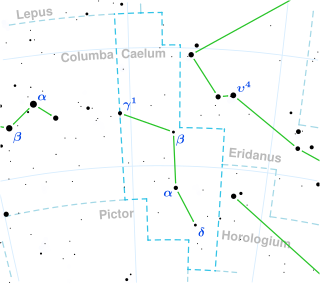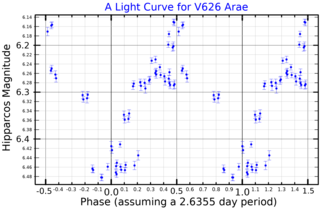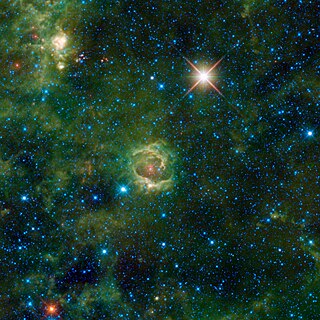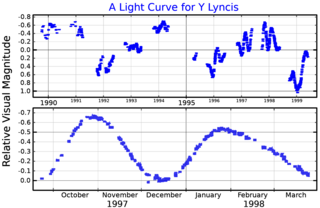82 Aquarii is a star in the equatorial constellation of Aquarius. 82 Aquarii is its Flamsteed designation. It has an apparent visual magnitude of 6.15, which, according to the Bortle Dark-Sky Scale, means it is a faint star that requires dark rural skies to view. The annual parallax shift of 82 Aquarii is 3.6764±0.1715 mas, which equates to a distance of roughly 890 light-years from Earth. Because this star is positioned near the ecliptic, it is subject to lunar eclipses.

Mu1 Cancri, Latinised from μ1 Cancri, is a variable star in the zodiac constellation of Cancer. The name Mu1 comes from the Bayer naming system: the "1" in the name is because (from Earth) it appears to be close to 10 Cancri, or Mu2 Cancri. It is also known by the variable star designation BL Cancri. The star is dimly visible to the naked eye with an apparent visual magnitude that ranges from 5.87 down to 6.07. Parallax measurements put it about 630 light-years (192 parsecs) from the Sun. At that distance, the visual magnitude is diminished by an extinction factor of 0.28. The position of the star near the ecliptic means it is subject to lunar occultations.
21 Cancri is a double star in the northern zodiac constellation of Cancer. It is just visible to the naked eye as a dim, red-hued star with an apparent visual magnitude of 6.08. The star is located around 791 light years away from the Sun, based on parallax. It is moving further from the Earth with a heliocentric radial velocity of 35 km/s.

R Centauri is a Mira variable star in the constellation Centaurus.

RV Caeli, also known as HD 28552, is a solitary, red hued variable star located in the southern constellation Caelum, the chisel. It has an apparent magnitude of 6.4, placing it near the limit for naked eye visibility. The object is located relatively far at a distance of 1,340 light years based on parallax measurements from Gaia DR3, but is rapidly receding with a heliocentric radial velocity of 98 km/s.

HD 160342 is a star in the southern constellation of Ara. HD 160342 is its Henry Draper Catalogue designation. It has an apparent visual magnitude of 6.35 and, based upon parallax measurements, is approximately 960 light-years distant from Earth.
HD 36678 is single star in the northern constellation of Auriga. This star is dimly visible to the naked eye with an apparent visual magnitude of 5.83. It is located at a distance of approximately 840 light years from the Sun based on parallax.

NO Aurigae is a pulsating variable star in the constellation Auriga. It is an unusually-luminous asymptotic giant branch star about 3,500 light years away.
HD 102350 is a single star in the constellation Centaurus. It has a yellow hue and is visible to the naked eye with an apparent visual magnitude of 4.11. The distance to this star is approximately 390 light years based on parallax, but it is drifting closer with a radial velocity of −3 km/s. It has an absolute magnitude of −1.51.
61 Leonis is a possible binary star system in the zodiac constellation of Leo. It is faintly visible to the naked eye, having an apparent visual magnitude of 4.73. The star is moving closer to the Sun with a heliocentric radial velocity of −12.7 km/s. It is located roughly 580 light-years from the Sun, as determined from its annual parallax shift of 5.58 mas.

PZ Cassiopeiae is a red supergiant star located in the Cassiopeia constellation, and a semi-regular variable star.

QZ Puppis is a class B2.5V star in the constellation Puppis. Its apparent magnitude is 4.5 and it is approximately 650 light years away based on parallax.

1 Puppis is a single star in the southern constellation of Puppis. It lies in the northern part of the constellation at a distance of about 790 ly, east of Aludra in Canis Major and just north of the white supergiant, 3 Puppis. This object is visible to the naked eye as a faint, red-hued star with an apparent visual magnitude of 4.59. It is moving further from the Earth with a heliocentric radial velocity of +32.4 km/s.

V1073 Scorpii is a variable star in the constellation Scorpius. It has a non-Greek Bayer designation of k Scorpii. The star has a blue-white hue and is visible to the naked eye with an apparent visual magnitude that fluctuates around +4.87. Parallax measurements yield a distance estimate of approximately 2,920 ly (896 pc) from the Sun, and it is drifting further away with a radial velocity of +7 km/s. It has an absolute magnitude of −6.8

Y Lyncis is a semiregular variable star in the constellation Lynx. It is an asymptotic giant branch star of spectral type M6S, with a luminosity class of Ib, indicating a supergiant luminosity. It is around 1,160 light years away.

V520 Persei is a blue supergiant member of NGC 869, one of the Perseus Double Cluster open clusters. It is an irregular variable star. At a magnitude of 6.55, V520 Persei is the brightest member in either NGC 869 or NGC 884, although the brighter HD 13994 lies in the foreground along the same line of sight.

U Lacertae is a spectroscopic binary star in the constellation Lacerta.

S Cassiopeiae is a Mira variable and S-type star in the constellation Cassiopeia. It is an unusually cool star, rapidly losing mass and surrounded by dense gas and dust producing masers.

RT Virginis is a variable star in the equatorial constellation of Virgo, abbreviated RT Vir. It ranges in brightness from an apparent visual magnitude of 7.7 down to 9.7, which is too faint to be visible to the naked eye. Based on parallax measurements made with the VLBI, the distance to this star is approximately 740 light years. It is receding from the Sun with a radial velocity of 17 km/s.

8 Leonis Minoris is a solitary, red hued star located in the northern constellation Leo Minor. It has an apparent magnitude 5.37, making it faintly visible to the naked eye. Based on parallax measurements from the Gaia satellite, the object is estimated to be 492 light years distant. It is receding with a heliocentric radial velocity of 40 km/s. At its current distance, 8 LMi is diminshed by 0.12 magnitudes due to interstellar dust.














